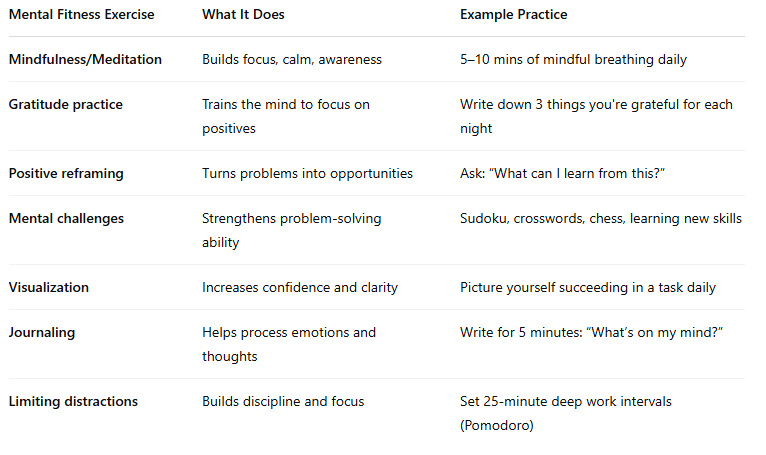Granted, we all want to be successful. We should absolutely work towards our goals, define our success, and march towards it.
Here is a question that arises in our minds -” How do Successful People Think”?
In general, we are all the same in terms of what we do in our lives. Then what is the curiosity the everyday person has in mind about successful people, in terms of their thought process?
Successful people tend to have certain mental habits and thought patterns that set them apart. Here are some key ways they think:
1. Long-term focus with short-term action
They think in terms of big goals but break them into small, actionable steps.
“What can I do today that moves me one step closer?”
2. Growth mindset
They believe they can learn, adapt, and improve, rather than being fixed in talent or ability.
“I may not know it yet, but I can figure it out.”
3. Opportunity-focused
Instead of obsessing over obstacles, they focus on possibilities and solutions.
“What’s the opportunity here?”
4. They ask good questions
They constantly challenge their assumptions.
“Why not?” or “What’s stopping me?” or “What would this look like if it were easy?”
5. They think in terms of value creation
They consider how their actions help others, not just themselves.
“How can I make this useful or meaningful for others?”
6. Resilience & Detachment
They know failure and criticism are part of the game and don’t take setbacks personally.
“What’s the lesson here? Move on.”
7. They control what they can
They don’t waste time on what’s beyond their control.
“What’s in my power right now?”
Are successful people wired differently in their brains or do they practice certain things to become successful?
They’re not necessarily wired differently; they wire themselves differently through consistent practice.
Some people might have natural tendencies (like curiosity, discipline, or confidence), but for most successful people:
They train their brains through habits, routines, and intentional practice.
They build mental muscles the same way athletes build physical muscles.
Here’s what science and observation tell us:
1. Neuroplasticity is real.
The brain changes based on what you repeatedly think and do.
So successful people become better at focus, problem-solving, and resilience by doing those things regularly.
2. They practice mental fitness.
Daily reflection
Goal-setting
Visualizing success
Managing stress
Staying curious
3. They manage their environment.
Surrounding themselves with positive, driven people
Avoiding distractions
Consuming content that educates and uplifts
4. They make failure a teacher, not an enemy.
Instead of saying “I can’t”, they learn to say “I can’t yet.”
They get comfortable with discomfort, knowing that’s where growth happens.
Here are some living examples of people who did not possess superpowers but did a lot of mental training to become successful
🌿Oprah Winfrey
Background: Born into poverty in rural Mississippi, faced abuse and many personal challenges.
What she trained: Emotional intelligence, communication skills, deep empathy, and resilience.
Impact: Built a media empire, became a billionaire, and one of the most influential women in the world.
Mental Fitness Skill: Self-reflection and relentless curiosity.
🌿J.K. Rowling
Background: Struggled as a single mother living on welfare before publishing Harry Potter.
What she trained: Imagination, storytelling, persistence through rejection (dozens of publishers said no).
Impact: Created one of the most successful book franchises ever.
Mental Fitness Skill: Resilience and clarity of vision.
🌿David Goggins (ex-Navy SEAL, author of Can’t Hurt Me)
Background: Grew up in an abusive household, obese, struggling with learning issues.
What he trained: Radical self-discipline and mental toughness.
Impact: Became an ultramarathon runner, elite military man, and motivational figure.
Mental Fitness Skill: Mental toughness, self-talk, and pain tolerance.
What is neuroplasticity?
Neuroplasticity is one of the most fascinating and empowering things about the human brain.
In simple terms:
Neuroplasticity is your brain’s ability to change, adapt, and rewire itself based on experience, learning, and repeated practice.
Think of it like this:
Your brain is not a fixed machine. It’s more like a garden:
Whatever thoughts, habits, and skills you “water” and “nurture” will grow stronger connections (neural pathways).
Whatever you neglect or stop using will fade away (those pathways weaken).
Two types of neuroplasticity:
Structural neuroplasticity — The brain physically changes its wiring by growing new neurons or connections between neurons.
Functional neuroplasticity — The brain shifts functions from one area to another if needed (like after an injury or to compensate for a weakness).
Everyday examples:
Learning a new language: At first, it’s hard. But with practice, your brain creates stronger pathways, making it easier and more automatic.
Breaking bad habits: When you stop a habit and replace it with a better one, the old brain pathway weakens, and the new one strengthens.
Mindfulness & meditation: Proven to change areas of the brain linked to focus, compassion, and stress regulation.
The cool part:
It happens at any age.
For a long time, people thought only kids had this ability, but research has shown that even into old age, our brains can reshape and adapt.
Why it matters:
You can train yourself to think more positively, be more disciplined, become a better learner, or handle stress better — by repetition and intentional practice.
It’s the science behind why “successful thinking” or learning new skills is not magic — it’s biology.
Here are 5 simple daily practices you can start using to boost neuroplasticity — basically helping your brain get sharper, more adaptable, and more focused:
1. Learn Something New (Even if small)
The brain loves novelty — learning forces new pathways.
Read a few pages from a book outside your comfort zone.
Learn one new word in another language.
Watch a short tutorial video on something unrelated to your work.
✅ Tip: Consistency matters more than quantity.
2. Practice Focused Attention (Mindfulness)
Just 5–10 minutes a day can rewire your brain for focus and calm.
Sit still, focus on your breath or a single thought, and gently pull your mind back when it wanders.
✅ It builds stronger attention circuits and reduces mental clutter.
3. Visualize Success or Problem-Solve Mentally
The brain treats vivid imagination as practice.
Close your eyes for 2–3 minutes and visualize yourself succeeding in something you’re working on — imagine the steps, the feelings, the outcome.
✅ Strengthens neural patterns associated with confidence and execution.
4. Challenge Your Brain (Break Routine)
Routine creates autopilot; breaking it sparks plasticity.
Take a different route to work.
Use your non-dominant hand for simple tasks.
Try a puzzle or a brain teaser.
✅ Forces your brain to “wake up” and grow new connections.
5. Sleep Well (7–8 hours if possible)
Neuroplasticity mostly happens during deep sleep — that’s when your brain reorganizes and stores what you learned.
✅ Good sleep = stronger memory, clearer thinking, better mood.
What is mental fitness?
Mental fitness is like physical fitness — but for your mind.
It’s the ability to handle life’s challenges with calm, clarity, focus, and resilience.
It’s about training your mind to stay positive, creative, and adaptable — especially when things get tough.
Key traits of mental fitness:
Clarity of thought — You can think through problems without overwhelm.
Emotional control — You respond instead of react.
Focus & attention — You can stay on task without distraction.
Resilience — You bounce back quickly from setbacks.
Optimism — You look for solutions and opportunities, not just problems.
How to build mental fitness (practical ways):
Final thought: We have now learned that successful people are not born but those who train their minds. Incremental improvements in our thoughts and practices can lead to large outcomes. What does that mean? We all can become successful and its all in the mind.





